Employee Performance Review Engagement Strategies: Supercharge Your Q4 2025 Annual Reviews with Personalization & Video
Estimated reading time: ~14 minutes
Key Takeaways
- Shift from static annual reviews to continuous feedback approaches
- Leverage automation and personalization at scale
- Incorporate video messaging for emotional and memorable engagement
- Develop structured Q4 communications for better completion rates
- Emphasize forward-looking development to boost retention
The very phrase annual performance review can trigger a collective groan across any organization. For employees, it often feels like a retrospective judgment. For managers, it’s a mountain of paperwork. For HR leaders, it’s a logistical nightmare that frequently fails to inspire, motivate, or retain top talent. In 2025, this outdated model is no longer just ineffective—it’s a liability. The future of workforce management demands a seismic shift from static, once-a-year evaluations to dynamic, engaging, and continuous conversations. This is where modern employee performance review engagement strategies come into play.
Welcome to the new era of performance management, where data-driven personalization, scalable video messaging, and intelligent automation are not just buzzwords but essential tools for building a resilient, motivated, and high-performing workforce. If you’re an HR leader planning for Q4 2025, this guide will provide a comprehensive blueprint to transform your annual reviews from a dreaded administrative task into a powerful engine for engagement and growth.
Section 1: Introduction to Employee Performance Review Engagement Strategies
At its core, the term employee performance review engagement strategies refers to the integrated set of tactics and technologies that HR leaders deploy to keep employees motivated, informed, and psychologically committed throughout the entire review cycle. It’s about transforming a top-down monologue into a collaborative, continuous dialogue. The goal is to ensure that by the time the formal Q4 review occurs, there are no surprises, and both the employee and the manager see it as a valuable capstone to a year of ongoing feedback and development.
The data overwhelmingly supports this proactive approach. When employees understand their direct impact on the company’s success, they are a staggering 3.5 times more likely to be engaged. This connection between contribution and company goals is the bedrock of effective performance management.
Looking ahead to 2025, the most significant trend is the definitive move away from static annual reviews toward continuous, data-driven feedback loops. Forward-thinking organizations are leveraging HR personalization technology 2025 to create a more agile and responsive system. This new paradigm emphasizes real-time recognition, frequent check-ins, and future-focused coaching, ensuring that performance cycle engagement enhancement is an ongoing priority, not a year-end scramble.
Source: www.thrivesparrow.com/blog/performance-management-statistics
Source: www.deel.com/blog/performance-management-trends/
Section 2: The Role of Automation & Personalization in Performance Reviews
The days of generic, one-size-fits-all review templates are over. To truly engage a diverse workforce, personalization at scale is critical. This is where automation becomes an HR leader’s most powerful ally, enabling individualized feedback without burying managers in administrative work.
What is Annual Review Personalization Automation?
Annual review personalization automation is the use of sophisticated software to automatically generate individualized review elements at scale. Instead of managers starting with a blank document, the system populates a draft with data-backed insights, narratives, and development suggestions unique to each employee.
Key components of this automation include:
- Data Ingestion: The system automatically pulls quantitative and qualitative data from multiple sources, such as goal progress from OKR platforms, 360-degree feedback from peers, sales figures from a CRM, and project completion rates from a project management tool.
- AI-Driven Narrative Templates: Advanced AI models analyze this data to generate draft narratives. For instance, it can translate “achieved 150% of Q3 sales target” into a compelling summary: “John demonstrated exceptional performance in Q3 by exceeding his sales target by 50%, significantly contributing to the team’s revenue growth.”
- Auto-Scheduling & Prompts: The platform can automatically schedule manager-employee check-ins and send intelligent prompts to managers before these meetings, suggesting key talking points based on recent performance data.
The Power of Personalized Manager Feedback Systems
Beyond automating the review document itself, personalized manager feedback systems act as a real-time coaching tool for leaders. These platforms provide managers with tailored talking points, questions to ask, and potential development paths for their team members, ensuring feedback is consistent, fair, and impactful.
The results are compelling. Companies that leverage AI and automation for performance management are twice as likely to hit their employee engagement targets. This technology empowers managers to be better coaches, transforming the review from a simple evaluation into a meaningful career conversation.
A typical workflow might look like this:
- Data Export: At the end of a performance period, the HRIS automatically exports key employee metrics (e.g., goal completion, training hours, peer feedback scores).
- API Trigger: This data export triggers an API call to a personalization engine.
- Content Generation: The engine generates personalized content, including a draft review narrative for the manager and a unique link to a personalized video for the employee summarizing their key achievements.
- Automated Delivery: A system-generated email or SMS is delivered to the manager with a link to the pre-populated review form and coaching prompts. Simultaneously, the employee might receive a notification to expect their review discussion soon.
Source: www.hoopshr.com/blog/measure-and-improve-employee-performance-2025/
Section 3: Scalable Communication Strategies for Q4 Reviews
A successful Q4 review cycle doesn’t start in December; it begins with a well-orchestrated communication campaign in early Q4. Proactive, transparent, and multi-channel communication is essential to prepare employees, set clear expectations, and reduce the anxiety often associated with year-end evaluations.
Designing Effective Q4 Employee Communication Campaigns
Q4 employee communication campaigns are multi-touch programs running from October to December, designed to guide employees and managers through every step of the year-end review process. The goal is to eliminate confusion and ensure everyone is aligned and prepared.
An effective campaign typically includes these components:
- Official Kickoff: An email or a short video from the CHRO or CEO in early October, outlining the timeline, philosophy, and importance of the upcoming reviews.
- Monthly Pulse Surveys: Quick, anonymous surveys to gauge employee sentiment and identify any widespread concerns about the review process.
- Bi-Weekly Manager Newsletters: Targeted communications for managers, offering tips, best practices, deadline reminders, and resources for conducting effective reviews.
- Employee Prep Resources: Distributing checklists, self-assessment guides, and articles on how to receive feedback constructively.
- Automated Calendar Invites: System-generated invites for 1:1 review meetings to ensure they are scheduled well in advance.
The Magic of Scalable Performance Review Communications
The key to managing this at scale is leveraging scalable performance review communications. This involves using templated content with dynamic fields that are automatically populated with employee-specific information. A single template can be used to generate thousands of unique messages.
For example, a reminder email could be personalized with fields like [Employee Name], [Manager Name], [Team Name], and [Top Q3 Achievement]. These personalized messages can be delivered through the channels employees use most, such as email, SMS, Slack, or Microsoft Teams. This level of personalization makes mass communications feel individual and relevant.
This strategy has a proven impact. Organizations that implement structured closing-year engagement campaigns see review completion rates increase by as much as 40%.
Sample Q4 Review Messaging Calendar:
- Week 1 (Early Oct): A kickoff video from the CEO is sent to all employees, explaining the “why” behind the review process. A link to the first pulse survey is included.
- Week 3 (Mid-Oct): Managers receive an auto-personalized video reminder from the Head of HR, outlining their role and key deadlines.
- Week 5 (Early Nov): Automated emails with pre-written templates are sent, prompting employees to request peer feedback.
- Week 7 (Mid-Nov): System-generated nudges with dynamic deadlines are sent to employees and managers who have not yet completed their self-assessments or reviews.
Source: blog.springworks.in/closing-the-year-strong-how-employee-engagement-will-shape-your-2025-workforce/
Section 4: Utilizing HR Video Messaging Platforms & Recognition Videos
Text-based communication can only go so far. In a world saturated with emails and instant messages, video cuts through the noise. It conveys tone, emotion, and sincerity in a way that text cannot, making it a uniquely powerful tool for employee engagement, especially during the sensitive performance review period.
What is an HR Video Messaging Platform?
An HR video messaging platform is a specialized system that automates the creation and delivery of personalized video messages for a wide range of employee communications. These platforms integrate with HR systems to pull employee data and use it to generate unique, one-to-one videos at an incredible scale. Platforms like TrueFan AI enable enterprises to connect with their employees in a hyper-personalized and emotionally resonant way.
For example, TrueFan’s Enterprise API can accept a simple JSON payload containing an employee’s name, a custom message, and an image URL. Within seconds, it returns a link to a high-quality video where a company leader or even a celebrity spokesperson delivers that message directly to the employee, by name.
Sample API Payload Snippet:
{
"vendor_id": 5,
"data": {
"p1_text": "Sarah Miller",
"p2_text": "Congratulations on exceeding your Q3 targets and landing the Apex account!",
"p1_image": "https://.../sarah_miller_photo.jpg"
}
}
The Unmatched Impact of Employee Performance Recognition Videos
Employee performance recognition videos are short, personalized clips that feature a spokesperson acknowledging an individual’s specific achievements. Instead of a generic “good job” email, imagine an employee receiving a video from their CEO saying, “Hi Priya, I was so impressed with how you led the Project Fusion launch. Your leadership was critical to our success this quarter.”
The benefits of this approach are immense:
- Emotional Resonance: Video creates a genuine human connection, making the recognition feel more significant and memorable.
- Higher Engagement: Personalized videos command attention. For instance, a TrueFan case study with Goibibo revealed a 17% lift in read rates on WhatsApp when messages included personalized videos.
- Enhanced Recall: Employees are far more likely to remember personalized video feedback than a line of text in a performance review document.
By integrating video into your Q4 review process—whether it’s a personalized thank you for a great year or a forward-looking message about development goals—you can dramatically amplify the positive impact of your feedback.
Source: TrueFan Case Study Data
Section 5: Engagement Enhancement Techniques During Performance Cycles
True performance cycle engagement enhancement isn’t a one-time event; it’s a continuous process. To avoid the year-end crunch and ensure reviews are fair and comprehensive, engagement must be nurtured throughout the year. This requires a shift from an annual event to an ongoing system of feedback, alignment, and recognition.
Here are three powerful techniques to maintain high engagement across the entire performance cycle:
1. Institute Weekly Micro-Check-ins:
Forget monthly 1:1s that get perpetually rescheduled. Implement lightweight, weekly micro-check-ins. These can be facilitated by chatbots, simple calendar prompts, or a dedicated platform where employees answer three quick questions: What did you accomplish last week? What are your priorities this week? Are there any roadblocks? The data is clear: organizations that conduct weekly check-ins see 85% higher employee engagement.
2. Adopt Agile OKRs (Objectives and Key Results):
Annual goals are often obsolete by Q2. Adopt a more agile approach by setting 60-day or quarterly OKRs. This allows teams to pivot quickly and ensures that individual goals remain tightly aligned with evolving business priorities. Using collaborative dashboards where progress is visible to everyone fosters transparency and a sense of shared purpose.
3. Enable Real-Time Peer Recognition:
Don’t wait for the annual review to celebrate wins. Integrate a peer recognition system directly into your daily workflows, such as a Slack or Teams app where employees can give “kudos” or award badges to colleagues for their great work. This creates a culture of appreciation and provides a rich source of qualitative data for performance reviews.
Furthermore, adopting a 360-degree feedback model is crucial. Gathering input from peers, direct reports, and managers yields a more balanced and comprehensive view of an employee’s contributions. This holistic approach not only makes reviews fairer but also fosters a stronger culture of development and mutual accountability.
Source: www.thrivesparrow.com/blog/performance-management-statistics
Section 6: Addressing Employee Retention During Reviews
Performance reviews can be a high-stakes period for retention. A poorly handled review can be the final push that sends a valued employee looking for other opportunities. Conversely, a thoughtful and well-executed review can significantly reinforce an employee’s commitment to the organization. The key is to position the review as a forward-looking investment in their career, not just a backward-looking assessment.
Effectively managing employee retention during reviews requires a strategic focus on career development and recognition. Here are three powerful strategies:
1. Link Review Outcomes to Personalized Development Plans:
Don’t just discuss past performance; build a bridge to the future. For every area of development identified, the review should immediately link to tangible next steps. This could include pre-approved online courses, mentorship opportunities with senior leaders, or assignments to stretch projects. Showing employees a clear, actionable path for growth demonstrates that the company is invested in their success.
2. Deploy Recognition at Scale, Instantly:
Capitalize on the positive momentum of a great review. For your top performers, don’t wait weeks to acknowledge their accomplishments. Use technology to send personalized video thank-you messages from leadership within 24 hours of the review’s completion. This immediate, high-impact recognition reinforces their value and makes them feel seen and appreciated.
3. Schedule Continuous Career Conversations:
The annual review should not be the only time an employee’s career path is discussed. Use personalized manager feedback systems to prompt managers to have dedicated “career check-ins” with their team members at least twice a year, separate from performance evaluations. These conversations should focus exclusively on long-term aspirations, skill development, and potential career paths within the company.
The impact of this continuous feedback approach on retention is undeniable. Research from 2025 shows that firms with ongoing feedback and development conversations see 31% lower turnover compared to those still relying on traditional annual reviews.
Section 7: Case Study – TrueFan’s Enterprise Solutions for HR Communications
To understand the real-world application of these strategies, let’s examine how a leading technology platform enables scalable performance review communications and transforms HR engagement. TrueFan’s Enterprise vertical provides a powerful example of how hyper-personalized, API-driven video can be integrated into the Q4 review cycle.
The Hyper-Personalization Workflow
TrueFan’s platform is built for personalization at a massive scale. The workflow is elegantly simple yet incredibly powerful:
- Data Feed: An HRIS or other HR system exports a data file (e.g., a CSV or JSON feed) containing fields like Employee Name, Role, Review Score, and Key Milestone.
- API Ingestion: This data is sent to the TrueFan API, which ingests it and maps each piece of information to a variable in a pre-designed video template.
- Video Generation: The platform generates a unique, high-quality video for each employee, featuring a CEO, brand ambassador, or celebrity delivering a personalized message. This can include “virtual reshoots,” where the AI alters the speech and lip movements in existing footage to deliver new lines without requiring the spokesperson to return to a studio.
One of the platform’s most powerful features is its multilingual support. TrueFan AI's 175+ language support and Personalised Celebrity Videos allow a single campaign to be delivered in Hindi, English, Tamil, Bengali, and dozens of other languages with perfect, AI-driven lip-sync, ensuring every employee receives the message in their native language.
Integration Example for Q4 Reviews
Imagine this workflow integrated into your performance review process:
- Upon a manager marking a performance review as “complete” in the HR management system, a webhook triggers an API call to TrueFan.
- Within minutes, both the manager and the employee receive an email or a Microsoft Teams message containing a link to a personalized video.
- The video features the Head of People celebrating the completion of the review cycle and highlighting one of the employee’s specific goals for the upcoming year, all by name.
Analytics & ROI
The impact of these campaigns is not left to guesswork. Solutions like TrueFan AI demonstrate ROI through a comprehensive analytics dashboard. HR leaders can track critical metrics in real-time, including:
- Video view rates and completion rates.
- Engagement lift (measured through subsequent pulse surveys).
- Uplift in the speed of review completion across the organization.
The scale and impact are proven. In a massive B2C campaign for Zomato’s Mother’s Day, the platform generated 354,000 unique, personalized videos in a single day, driving unprecedented viral engagement. This same technology is now being harnessed by HR departments to drive internal engagement and make every employee feel uniquely valued.
Source: TrueFan Enterprise Executive Documentation
Section 8: Future of Performance Reviews in 2025 and Beyond
The evolution of performance management is accelerating. As we look beyond 2025, several key trends driven by HR personalization technology 2025 will reshape the landscape, making the process even more integrated, intelligent, and human-centric.
Generative AI & Real-Time Coaching:
The future lies in embedding coaching moments directly into daily workflows. Imagine a manager finishing a call and their system, powered by generative AI and video, instantly provides a one-minute personalized video with tips on how they could have handled a specific objection more effectively. This real-time, one-to-one coaching will become the new standard for continuous development.
Predictive Analytics for Skill Development:
AI models will become increasingly adept at proactive talent management. During a performance review, an AI might analyze an employee’s performance data, compare it to their career goals, and flag potential skill gaps. It could then automatically recommend specific internal training modules, external courses, or mentors to help close those gaps, creating a truly personalized upskilling journey.
Ethics, Compliance, and Trust:
As synthetic media becomes more common, the ethical implications will be paramount. Leading platforms will operate on a consent-first model, ensuring complete transparency and protecting employee data. Clear protocols for the use of AI-generated content will be essential to maintain trust and protect both employee privacy and brand integrity.
The ultimate goal of these future-forward employee performance review engagement strategies is to create a system where feedback is constant, development is continuous, and every employee has a clear understanding of how they can grow and succeed within the organization.
Frequently Asked Questions
1. What are the first steps to implementing personalized video in performance reviews?
Start with a specific, high-impact use case. A great first step is to create a post-review “Thank You” video campaign targeting your top performers. This allows you to test the workflow, measure engagement, and demonstrate value before rolling it out more broadly.
2. How can we measure the ROI of improved employee engagement during reviews?
Measure key metrics before and after implementation. Track metrics like review completion speed, employee turnover rates in the quarter following reviews, and sentiment scores from pulse surveys. Connect these people-centric metrics to business outcomes like productivity and retention cost savings.
3. Is this technology suitable for small businesses or just large enterprises?
While large-scale API-driven campaigns are typically for enterprises, many platforms offer solutions for smaller businesses. These might include self-service tools where you can upload a list of names and generate a batch of personalized videos without deep technical integration.
4. How does a platform like TrueFan AI ensure data privacy and security?
Leading platforms prioritize security through rigorous compliance standards like ISO 27001 and SOC 2 certifications. They operate on a consent-first model, ensuring both the celebrity/spokesperson and the end-user have opted in. All data is handled under strict privacy protocols, and user data is never repurposed without explicit permission.
5. What’s the biggest difference between continuous feedback and a traditional annual review?
A traditional annual review is a single, retrospective event focused on evaluation. Continuous feedback is an ongoing process focused on development. It involves frequent, lightweight check-ins, real-time recognition, and forward-looking coaching, making the formal “review” a summary of a year-long conversation rather than a one-time judgment.
Conclusion: Make Every Review an Opportunity
The annual performance review is at a critical inflection point. Continuing with the outdated models of the past is a recipe for disengagement, attrition, and administrative burnout. The path forward for visionary HR leaders is clear: embrace a holistic approach that blends human connection with intelligent technology.
By integrating continuous feedback loops, leveraging automation and personalization, and harnessing the emotional power of video, you can transform your Q4 2025 review cycle. You can shift the narrative from a dreaded obligation to a welcome opportunity—an opportunity to recognize achievement, clarify future goals, and reaffirm to every employee that they are a valued and vital part of your organization’s success. The time to supercharge your strategy is now.





